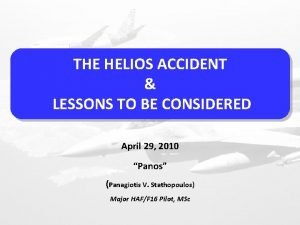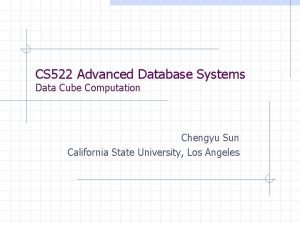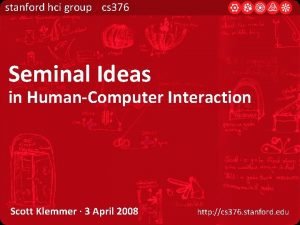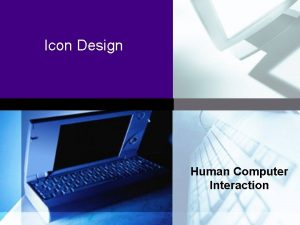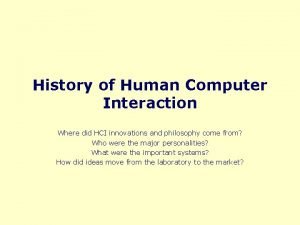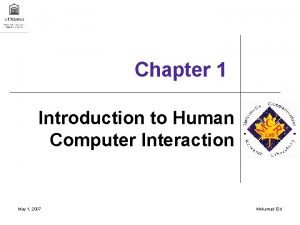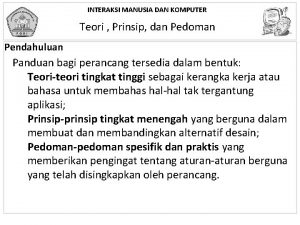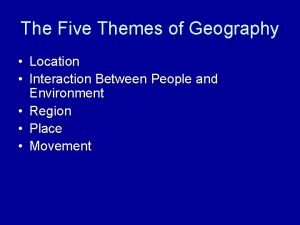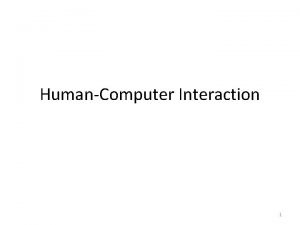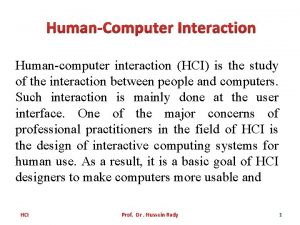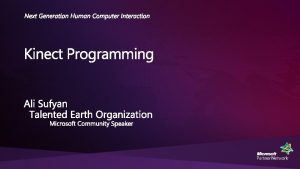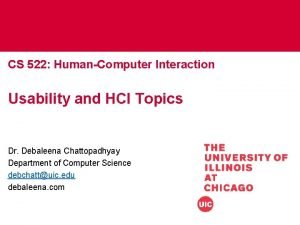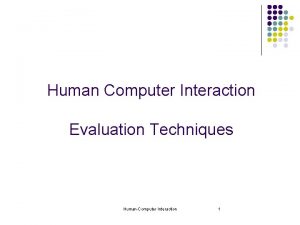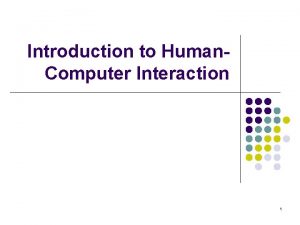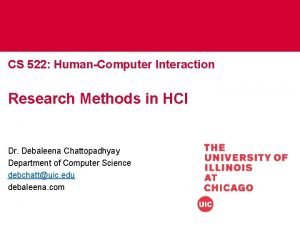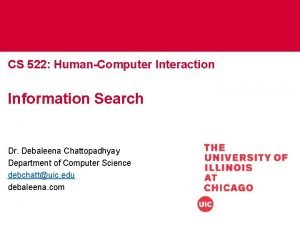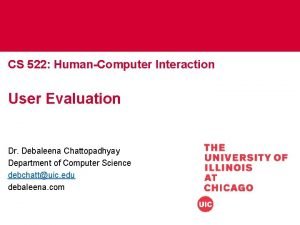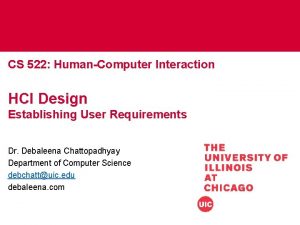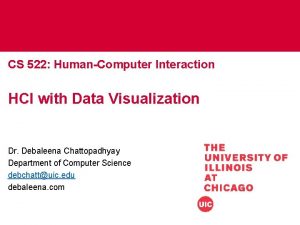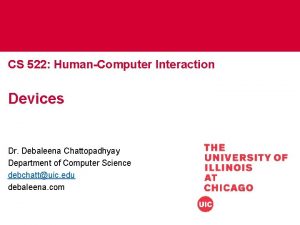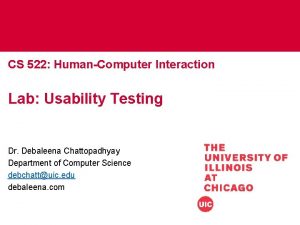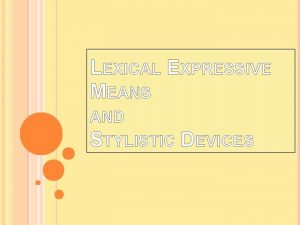CS 522 HumanComputer Interaction Expressive Human and Command






















- Slides: 22

CS 522: Human-Computer Interaction Expressive Human and Command Languages Dr. Debaleena Chattopadhyay Department of Computer Science debchatt@uic. edu debaleena. com

Expressive Human and Command Languages • • Speech recognition Speech production Human language technology Traditional command languages Introduction

Introduction • The dream of speaking to computers and having computers speak has long lured researchers and visionaries. • Arthur C. Clarke’s 1968 fantasy of the HAL 9000 computer in the book and movie 2001: A Space Odyssey has set the standard for performance of computers in science fiction and for developers of natural language systems.

ELIZA http: //www. masswerk. at/eliza/

Speech Technologies • • • Store and replay (museum guides) Dictation (document preparation, web search) Close captioning, transcription Transactions over the phone Personal “assistant” (common tasks on mobile devices) Hands-free interaction with a device Adaptive technology for users with disabilities Translation Alerts Speaker identification

Spoken Interaction Using Nuance Dragon. TM speech dictation and a head mouse (the little silver dot on his forehead), a computer scientist is able to overcome a temporary hand disability (http: //www. nuance. com/dragon/index. htm)

Opportunities for speech commands • • • When users have physical impairments When the speaker’s hands are busy When mobility is required When the speaker’s eyes are occupied When harsh or cramped conditions preclude use of a keyboard • When application domain vocabulary and tasks is limited • When the user is unable to read or write (e. g. children)

Obstacles to speech recognition • Interference from noisy environments and poor-quality microphones • Commands need to be learned and remembered • Recognition may be challenged by strong accents or unusual vocabulary • Talking is not always acceptable (e. g. in shared office, during meetings) • Error correction can be time consuming • Increased cognitive load compared to typing or pointing • Programming difficulty without extreme customization

Obstacles to speech production • Slow pace of speech output when compared to visual displays • Ephemeral nature of speech • Not socially acceptable in public spaces (also privacy issues) • Difficulty in scanning/searching spoken messages

Voice-activated Digital Assistants Social Implications • A few years ago, you would only see someone talking into their phone if somebody was on the other side • Fast forward a bit and now talking to your phone when you are not on a call is no big deal • Siri for i. Phone revolutionized the behavior, and nowadays it is common to see people use their voice to control their phones

Designing spoken interaction • • • Initiation Knowing what to say Recognition errors Correcting errors Mapping to possible actions Feedback and dialogs

Designing spoken interaction (continued) Mobile devices assistants (from left to right: Siri, Google. Now, Cortana and Hound) all have similar microphone buttons, but different ways of presenting suggestions

Designing spoken interaction (continued) • Correcting a word during dictation using Nuance Dragon. TM. • After saying “Correct finnish” the word is selected and possible corrections are displayed in a menu, along with additional commands such as “Spell that” • Users can use the cursor, arrow keys, or voice to specify their choice

Designing spoken interaction (continued) • It can be difficult to remember what exact command will accomplish the task • In this example when the user said “Search the web for Glacier National Park” a Google search was launched and a search executed with the correct terms, but when the user said “Do a web search for Glacier National Park” the text was indeed accurately recognized but not as a command, so the text was placed in the Nuance Dragon. TM dictation box

Designing spoken interaction (concluded) • A small subset of the rich set of commands used in the Nuance Dragon. TM speech recognition system • Synonyms are included and used consistently

Speech Production • Speech production is usually successful when the messages are simple and short; and users’ visual channels are overloaded • There are three general methods to produce speech: 1. Formant synthesis – machine-generated speech using algorithms 2. Concatenated synthesis – uses tiny, recorded human speech segments 3. Canned speech – fixed, digitized speech segments

Speech Production (continued) • Examples: – – – Audio books or audio tours Instructional systems Online help systems Alerts and warnings Applications for the visually impaired

Human Language Technology • Machines that understand natural language • Natural language interaction (NLI) – Series of exchanges or “dialog” is difficult to design and build, on even a single topic – Current successes often rely on statistical methods based on the analysis of vast textual or spoken data from millions of users • Example applications and methods include: – Question answering strategies – Extraction and tagging, e. g. gathering data from a database of medical records – Human language text generation – Instructional systems – Language translators, e. g. Google Translate

Human Language Technology (continued) • Using the Immersive Naval Officer Training System (INOTS) new navy officers can practice their counseling skills in a virtual reality environment • Officers listen to an avatar and respond using spoken language, loosely following suggestions from multi-choice prompts presented on the screen and designed to match the learning objectives • The interaction is constrained but assessment is facilitated

Human Language Technology (cont. ) • Google Translate, showing a French sentence translated in English

Command Languages • Command languages are often preferred by expert users who do not want to drag and drop items for repeated steps. • A command language example is the Unix command used to delete blank lines from a file – grep -v ^$ filea > fileb • Casual users favor GUIs but both styles of interface can be made available successfully • Other examples that behave like command languages: – Web addresses (URLs) can be seen as a form of command language – Twitter addresses – Database query languages

To do: • HW 2 – DUE today. • Readings: Buxton, 2007, Sketching User Experiences: Getting the Design Right and the Right Design, pp. 105— 151. • Next class—lab: Bring paper/sketchbook/notebook and pen/pencils. We will be sketching UIs in class Bring your user requirements…
 Andreas prodromou helios 522
Andreas prodromou helios 522 Numberblocks support materials
Numberblocks support materials Po box 63000 newark nj 07101
Po box 63000 newark nj 07101 Nasa std 6001
Nasa std 6001 Cube of 522
Cube of 522 It 522
It 522 Mit csail hci course review
Mit csail hci course review Human computer interaction logo
Human computer interaction logo Microprocessor in hci
Microprocessor in hci What are input and output channels in hci
What are input and output channels in hci History of hci
History of hci Examples of direct manipulation system
Examples of direct manipulation system Human computer interaction chapter 1
Human computer interaction chapter 1 Jelaskan tentang antarmuka generasi masa depan
Jelaskan tentang antarmuka generasi masa depan Prinsip imk
Prinsip imk Hei geography definition
Hei geography definition Spatial interaction ap human geography
Spatial interaction ap human geography Portland absolute location
Portland absolute location Spatial interaction ap human geography
Spatial interaction ap human geography Human computer interaction syllabus
Human computer interaction syllabus What is egypt relative location
What is egypt relative location Generalized map ap human geography
Generalized map ap human geography Spatial interaction ap human geography
Spatial interaction ap human geography
